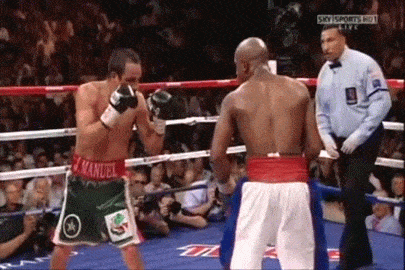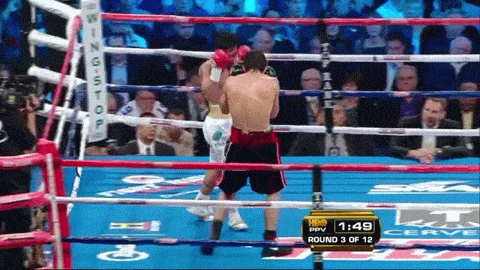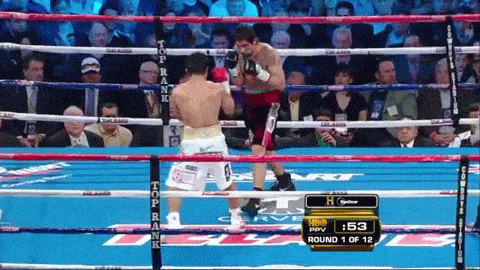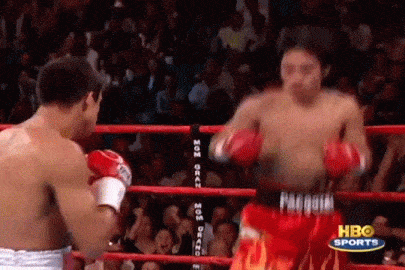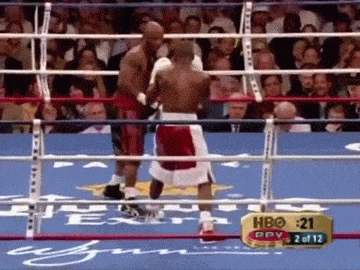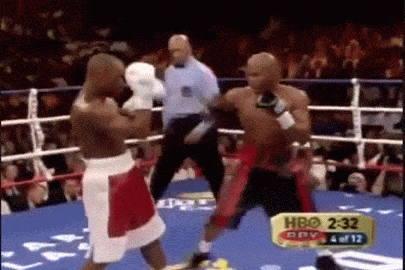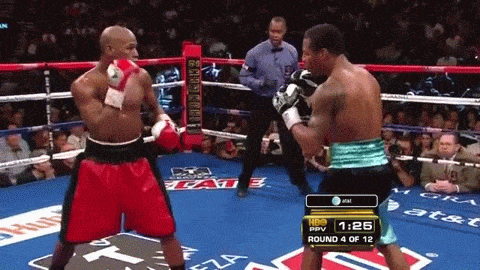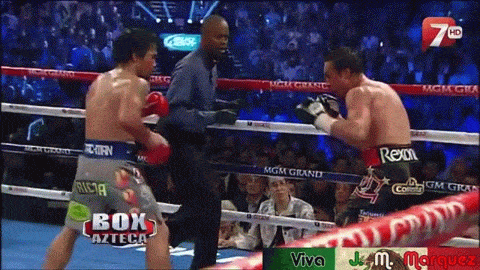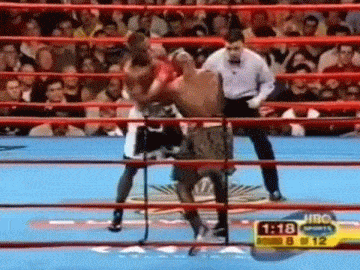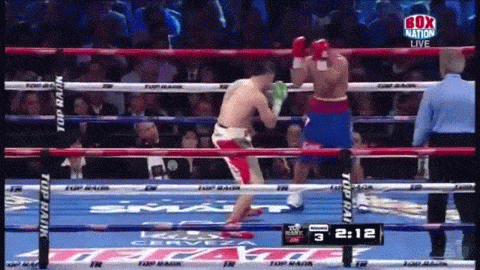ALREADY A SURE-FIRE fiscal phenomenon outside the ring, what remains to be seen is how the Floyd Mayweather/Manny Pacquiao match-up will ultimately unfold inside it.
Before breaking down the tactical nuances that are likely to have a say in that regard, it is important to first tally some of the nuts and bolts which underpin them.
While seemingly all of the figures concerning this event are prefixed with a dollar sign, it is those which feature on the tale of the tape that will be of foremost relevance come opening bell.
Speaking firstly of the age differential, although Pacquiao enters the ring two years Mayweather’s junior, it remains to be seen whether that will afford him any discernible advantage. After all, despite being the younger man, the Filipino has fought 18 more professional bouts than his counterpart, and an additional 44 rounds all told. His defeat to Juan Manuel Marquez in 2012 hinted that those extra exertions might have rendered him a little more battle-worn than battle-hardened, but three emphatic wins versus emergent contenders Brandon Rios (26), Timothy Bradley (30) and Chris Algieri (30) put paid to that notion.
Mayweather, save for an off-colour showing in last May’s win over Marcos Maidana, has also looked more the grand master than the elder statesman in recent times, seeing off his last five opponents (average age 27) with customary conviction.
As stats go, the reach discrepancy is unlikely to bear much undue influence either. Measured from the armpit to the end of the fist, Mayweather’s exceeds Pacquiao’s by five inches, and while against most this would represent a marked advantage, both men’s shared penchant for boxing at long and middle distance should make it a relative non-factor on the night.
To a large extent, it could be argued that the most significant of all the numbers included in the tale of the tape is an altogether more intangible one. Mayweather might be most widely known for the array of zeroes at the end of his bank balance, but it’s the ‘0’ in his record that is of primary concern this weekend. The following analysis will aim to pinpoint what he will need to do in order to protect it, as well as the tactics Pacquiao can use to take it away.
The Lead: Mayweather’s Left v Pacquiao’s Right
While the intersection of the Mayweather/Pacquiao Venn diagram is rather bare for the most part, speed is certainly something that is common to both competitors.
Whereas Mayweather’s tends to parlay into precision, Pacquiao’s is borne out by the tempo of his work. The battle lines, as such, can be drawn accordingly.
Each aspect of the match-up juxtaposes the ferocity and volume of the Filipino’s output against the timing and accuracy of his American counterpart. The lead is no exception.
And yet, although both are firmly established as the preeminent boxers of their generation, neither are notorious exponents of the punch in its conventional form.
Despite boasting an esteemed amateur pedigree, Mayweather has largely forgone the point-scoring jab upstairs during his stint in the professional game. He prefers to instead make use of his metronomic check-hook, a shot which involves throwing the lead whilst simultaneously using the left leg to swivel 180 degrees.
As illustrated in clip 1, the benefits of the technique are twofold. Along with warding off the possibility of a Marquez counter, pivoting in this fashion also presents a fresh angle to launch a second raid.
Even though it’s among the most revered weapons in his armoury, don’t be surprised if the check hook stays in the holster more often than not this time around. While in theory it is tailor-made for an aggressor of Pacquiao’s disposition, lesser lefties such as Victor Ortiz and Robert Guerrero have shown that the location of the right leg in the southpaw stance can impede the punch. Expect to see the 38-year-old adjust accordingly, compensating for the relative absence of his hook by bringing his jab productivity up to par.
This in itself will be quite a departure for somebody who routinely chooses to employ his straight lead in single doses, to the body, and as a means of maintaining distance rather than setting up combinations. Although seemingly not all that debilitating, its jarring nature usually proves enough to keep rivals honest on both sides of the ball. That is to say, as well as wilfully slowing down their own advances, the keenness of Mayweather’s challengers to ward off his jab downstairs often creates gateways for his power shots to the head.
As illustrated in Clip 2, Ricky Hatton is among the victims who fell foul in that regard. Despite the Briton’s relentless pressure paying dividends in the opening stanzas, Mayweather began to effectively use Hatton’s front-foot style against him in the middle rounds, catching him with stick shots as he came in.
By round 8 the American had brought his full offensive repertoire into play, peppering the then-undefeated Hitman with straight rights before ultimately stopping him in the 10th.
[image alt="http://i.imgur.com/XTAemSI.gif" src="http://i.imgur.com/XTAemSI.gif" width="480" height="270" credit-url="" credit-source="" credit-via="" credit-via-url="" class="wp-embed-data-node mceNodeTemp aligncenter" /end]
With Pacquiao’s erratic upper body movement making him notoriously difficult to gauge early on, expect Mayweather to try to establish a similar pattern with his jab.
That being said, Pacquiao presents an altogether more multi-faceted proposition than Hatton. And while a dearth of stellar amateur coaching saw him enter the pro-ranks with limited technical proficiency, spending the best part of two decades under the tutelage of six-time trainer of the year Freddie Roach has seen untold improvement in his core fundamentals.
It’s not necessarily a customary jab in the Larry Holmes mould, yet Pacquiao’s right lead is still a valuable tool. As shown in clip 3, the 36-year-old has developed what in tennis parlance could be described as an instant return of serve, something which former welterweight titlist Antonio Margarito learned to his cost.
Akin to Oscar De La Hoya, Margarito tried to push his smaller opponent back with ramrod leads, only for the Filipino to invariably make him pay with reflex counter jabs.
Reminiscent of Mayweather’s work to the body, these shots can often be something of a slow burner. In other words, even if apparently innocuous in isolation, Pacquiao’s repeated returns of fire have a cumulative effect, eventually making challengers hesitant to pull the trigger.
When it comes to launching his own leads, Manny has no such fear. Safe in the knowledge that orthodox operators are almost never in position to counteract a southpaw jab, he will regularly employ his as a single power shot behind a left hand, or as the final punch in a combination.
Clip 4, again from his fight against Margarito, shows both versions executed to maximum effect.
The Cross: Pacquiao’s Left v Mayweather’s Right
Gaining the upper hand with the outer hand will undoubtedly be a crucial staging post this weekend. However, as in all clashes of southpaw and orthodox fighters, it’s the cross that truly holds the key.
From Pacquiao’s perspective, the supplementary nature of his jab means that his left hand serves something of a dual role. That is to say, in addition to being the main source of his power shots, it’s also used to set up a variety of combinations.
And although the sheer volume of the Filipino’s output routinely overwhelms opponents, the frequency with which he has been made to miss, in recent outings especially, will be of concern.
Pacquiao will hence have to tread lightly with his cross, seeking out quality over quantity a little more than would ordinarily be his want. Feints, as such, are going to be imperative. The 42 rounds he spent with another vaunted technician in Marquez should be reminder enough of that.
Clip 5, an excerpt from the first of those, shows that among the most successful ways to disarm counterpunchers is by offsetting their timing with movement. In this case, Pacquiao adeptly draws Marquez into the pocket with a pump-fake before sending his left hand straight down the pipe.
Another significant tool in this respect is hand-speed, something which he has in abundance. Contrary to Marquez, however, Mayweather is one of few that can match him in that department. So whereas Pacquiao was able to intermittently stifle the Mexican’s replies with his quick-fire flurries, Mayweather’s own agility should limit any such tactics.
Roach will obviously have made allowances with that in mind, aware that his charge needs to be creative when it comes to making his fast hands a factor.
Fellow southpaw Zab Judah laid something of a blueprint in that regard, pushing Floyd close during their tussle for the IBF Welterweight Championship in 2006. On that occasion, the Brooklynite swept the beginning of the contest thanks to a varied and unpredictable blend of offence, using speed to bring left hands into play at every turn.
Unlike the bulk of Mayweather’s adversaries to date, Judah was content to concede the middle of the ring in the early going, trusting that his own manoeuvrability would allow him to box effectively on the back foot. As seen in Clip 6, by inviting Mayweather to press the action initially, Judah assumed the role of counterpuncher, his left hand seemingly linked by tripwire to Floyd’s leads.
Pacquiao is not necessarily averse to playing the matador himself, often happy to lure an opponent’s lead hand out of position with a view to landing his own. And while parity in handspeed offers him a legitimate foothold in the bout, his power has the potential to turn that into a stranglehold at a moment’s notice.
“It’s a unique hitting power, not necessarily physically strong, but he’s got phenomenal snap those gloves,” said Shane Mosley in the aftermath of their fight.
“I’ve been hit by much bigger guys and come through; no wobbling, no dazing. With Pacquiao, he just touches you and you’re already off balance. It’s weird. It’s the weirdest thing.”
While Mayweather has been able to subdue the power of conventional clubbers, fighters whose strength is rooted in speed have proven tougher nuts to crack.
Once again, Judah is case in point. Having boxed a picture-perfect opening three rounds, Zab staunchly planted his feet in the fourth. Clip 7 is another example of his effective aggression, wherein a feigned jab fashions the avenue for a forceful cross.
Pacquiao’s erratic movement and unorthodox angles should allow him to develop some similar attacking opportunities. After all, it took Marquez the guts of four attempts to truly get to grips with him, so don’t be surprised if Mayweather requires four rounds to do likewise.
Nevertheless, the fact that you can count on one hand the amount of times Floyd has been knocked on his heels speaks for the exceptionality of Judah’s performance during the first 12 minutes of their meeting.
The remaining 24, in contrast, went a bit more to script. Indeed, if Judah’s cross was central during the opening act, Mayweather’s ultimately stole the show. As seen in clip 8, by the fifth round he began tagging the now wilting IBF champion with bracing regularity, a pattern which continued through to the final bell.
The Compubox figures were testament to Mayweather’s general dominance from that point, deeming him to have landed 145 (49%) of his power punches compared to Judah’s 49 (36%).
In many ways, the numbers frame the importance of Floyd’s right hand better than words ever could. In that contest he favoured his cross over his lead at a rate of almost 2:1 (215:109), this compared to his southpaw opponent who eventually threw 173 more jabs than him in the final reckoning.
And while power unquestionably represents Pacquiao’s best chance of equalising that accuracy, it is worth noting at this juncture that Mayweather is not exactly feather-fisted himself. Although his brittle hands have robbed him of the raw knockout potential that saw off the likes of Genaro Hernandez and Diego Corrales, he has still showcased enough to keep much bigger men in tow during his journey through the weight classes.
That being said, power is nonetheless a secondary resource in his playbook; unerring precision is very much the rock upon which he has built his church. Unquestionably the most versatile weapon in the 38-year-old’s arsenal, his right hand’s effectiveness is predicated on the variety of circumstances under which it can arrive. As seen in the previous clip, one way he opts to set off the cross is by stepping into range behind it once he deems an opponent to be off balance.
Ever the artful dodger, he also regularly uses subtle body movement to entice opponents into harm’s way. Clip 9 contains some perfect examples of what can be described as a ‘pull counter’. Having drawn Mosley’s leads, Mayweather swings his body back in a pendulum motion to avoid them, enabling him to then commit his full weight to the return right hands.
As discussed earlier, Pacquiao will have to encumber Mayweather’s counters with movement. Successful though that might prove, Floyd’s tactical acumen will unquestionably garner some clear-cut opportunities sooner or later. He need look no further than the most recent Pacquiao/Marquez encounter for assurance of that.
By now wary of the pump-fake which put him on the seat of his pants during their first meeting, the Mexican had his cross loaded this time around. By ducking under Manny’s jab in clip 10, Marquez creates the leverage for his own fearsome overhand right.
Defence: The Battle for Territory
If the tenets of boxing can be boiled down to ‘hit’ and ‘don’t get hit’, Mayweather personifies them in living colour. Indeed, so proficient is he in the art that he was christened ‘Pretty Boy’ upon his entry into the sport. That moniker may have faded in the intervening years, but his ability to evade punishment remains unparalleled.
Although head movement is generally considered Defence 101, Mayweather’s punch evasion techniques encompass the entire upper body. As seen in clip 11, rather than merely bobbing side to side, he pivots his hips, enabling him to either slip or deflect Carlos Baldomir’s blows both upstairs and down.
His legs have also long since been paramount to his impregnability, allowing him to control ring real-estate throughout his career. But as previously noted, his most recent outings against Maidana suggest he may not quite have the flexibility of yore. The Argentine, a fighter not renowned for his quickness, managed to effectively close distance throughout their 24 rounds.
Pacquiao, who is infinitely more fleet of foot than Maidana, will thus fancy his chances of doing the same.
Contrary to popular belief, however, Mayweather is wholly capable of holding his own in the centre of the ring. And although his current tendency to stand and trade is likely a by-product of his decreased mobility, he’s never been one to shirk a battle in the pocket.
Clip 12, for example, dates back 11 years to his 2004 bout with another lefty in DeMarcus Corley. By mixing it up inside with Corley, Mayweather knew that he could smother the DC native’s longer reach and, in so doing, set the table for his own responses.
Like all counterpunchers worth their salt, Mayweather’s first line of attack is his defence. If lateral movement is his most effective tool in that respect, the ‘shoulder roll’ is unquestionably the one with which his he his most widely associated. This technique involves holding the right hand tall and the left hand around the midsection, thus allowing the lead shoulder to protect the chin.
The mechanics are used to full effect in Clip 13. Having caught Mosley’s shot on his left arm, Mayweather swivels to return the favour with his right.
The method is not airtight, however, and has been susceptible to both orthodox jabs and straight left hands in the past, most notably versus another Roach-trained fighter in Oscar De La Hoya.
The knowledge that his strongest punch doubles as the kryptonite for his opponent’s go-to defensive manoeuvre should give Pacquiao something of a mental edge, in that department at least.
As discussed in the first section, although a significantly shorter-armed fighter, the Filipino is also partial to working from the outside. That is to say, while the majority of his best work is done at close quarters, his preference is to slalom in and out of the pocket in short bursts rather than to stand and trade. This peekaboo style of offence is framed in clip 14.
Instead of planting his feet in centre-ring, Pacquiao uses his peerless hand and foot speed in order to quickly change range, thus allowing him to land flurries on the way in and dodge Marquez’s on the way out.
In addition to making best use of Pacquiao’s raw athletic attributes, Roach has also furnished him with some astute tactical sophistication. In no realm is this more apparent than when it comes to his charge’s angular movement. For instance, although flying in the face of conventional wisdom, Manny is prone to circling left rather than right when confronted with an orthodox operator.
Whereas the majority of southpaws adopt the opposite tack in order to maintain distance from any oncoming right hands, Pacquiao’s intention is to deter his opponent from throwing the shot by cocking his own cross. What’s more, instead of attempting to time the other guy’s punches in the traditional sense, his inclination is to offset his opponent’s attacking movement with pre-emptive strikes.
This can be seen in Clip 15, an excerpt from round 3 of his 2013 dismantling of Rios. By initially retreating in his defensive stance, he entices the Mexican to venture into the space that he has vacated.
While Rios thinks he is cutting him off and thus creating an opportunity to attack, Pacquiao is one step ahead. Almost as soon as soon as Rios sets his feet, Pacquiao lands a double left-hand and spins off.
If the majority of his style is eccentric, his guard is noticeably less so. Indeed, practically all of Pacquiao’s work comes behind an old-fashioned earmuff stance. As well as allowing him to deflect and parry straight shots, this method also ensures that both of his hands are primed to promptly fire back.
In no scenario is the more visible than when it comes to that trusty counter right hand, whereupon he again uses his keen understanding of range to sucker opponents into middle-distance. A la Rios, Morales is drawn into an attacking stance by Pacquiao’s back foot movement in clip 16. Already overextending and imbalanced when he launches his wayward cross, his mistake is compounded further when Manny tags him with a reflex right and a follow-up 1-2.
Final Verdict: Weighing up the potential outcomes
Not since a pair of heavyweights stepped through the ropes at New York’s Madison Square Garden in 1971 has boxing perforated the global consciousness to quite this extent. On a night when somebody’s O had to go, it was Kentucky’s Muhammad Ali who succumbed, forgoing his unblemished record to one Joe Frazier.
The dynamic of this weekend’s bout, though not identical, bears more than a passing resemblance. Indeed, as with Ali/Frazier, the pre-fight narrative being pedalled is that of back-foot boxer versus front-foot brawler.
The Las Vegas betting line is on board in that regard, favouring Mayweather to win should the bout go 12 rounds (4/6), and Pacquiao to emerge victorious should it not (9/2). If recent form is anything to go by, however, a strong argument can be made for the exact opposite.
Akin to the conjecture surrounding Pacquiao this time around, in 1971 it was presumed that Frazier’s best chance of victory was by curbing Ali’s enthusiasm with a cannonball left hand. And while Smokin’ Joe did make his hook a factor in proceedings, it was his intensity and work rate which truly won out, allowing him to overwhelm his adversary down the stretch.
If Manny is to claim victory this weekend, he would be best served trying to repeat that particular dose. Ostentatious declarations of war notwithstanding, his camp will surely know that this assignment calls for brains rather than brawn. After all, the Filipino has gone nine outings without securing a stoppage, and his tenth attempt is versus an individual who hasn’t suffered an official knockdown in his career, let alone a knockout.
Pacquiao doesn’t quite possess the aptitude for ring generalship which Frazier displayed on that night, but he has got the attributes to disrupt Mayweather in other ways. As such, instead of trying in vain to cut the ring off like Joe did with Ali, he would be better served attempting to pre-empt Floyd’s movement by setting some of the traps discussed earlier.
While volume and work rate represent his best chance of victory, overcommitting on those fronts could, by the same token, prove his very undoing against an accomplished counterpuncher. Balance, therefore, is key.
In other words, although it is in Pacquiao’s best interests to outwork Mayweather, that is not necessarily tantamount to pressing the action. If anything, he must invite Floyd to close the distance.
By forcing him to initiate exchanges, he can nullify the threat of counterpunches. Once in the pocket, and safe in the knowledge that Mayweather will likely lead off one shot at a time, Manny needs to draw on his superior capacity for volume by responding in kind with combinations. Whereas most boxers function in three-minute increments, he needs to scale it down even further, operating exchange-by-exchange, each separate dual representing a fight within a fight.
This sport, complex though it may be, is fundamentally quite simple in that sense. Winning exchanges equals winning rounds, and winning rounds equals winning bouts.
In contrast to Messrs Judah, De La Hoya and Maidana, Pacquiao certainly has the stamina and skill required to carry the game plan all the way through. Whether he has the discipline remains to be seen.
The latter, of course, is a question that certainly cannot be asked of his opponent. Even if Mayweather ultimately comes up short on Saturday, it won’t be for lack of mental fortitude. The fact that he can hopscotch between cornermen, from father Floyd Sr. to uncles Jeff and Roger and then back again, shows that, above all else, he backs himself to adjust in heat of battle. Psychology aside, however, he will have to call on more tangible reserves to get the job done this weekend.
While increasing his overall output above the waterline is important, pedestaling quality above quantity endures as priority number one. Despite likely being under instruction not to, Pacquiao’s instinctual tendency to aggress means he is still liable to blink first should any sustained lulls emerge. In these instances, Mayweather’s single punch handspeed should shine through. Pot-shots on the back foot score points, but they won’t be enough to deter Manny’s overtures.
To that end, it’s worth noting that for only the third time since 2007, Mayweather steps into the ring as both the taller and longer-limbed fighter. Although reach is a relative non-factor for the reasons outlined earlier, the American’s broader frame does represent a tangible advantage, and one which he is not ordinarily afforded.
Furthermore, unlike most counterpunchers, he has the capability to switch tack and turn the tables. Miguel Cotto and Saul Alvarez can attest to that. Those two are scheduled to meet later this year at the middleweight limit of 160 pounds, and yet it’s not so long ago that both men found themselves being pushed back by a man who walks around at 147.
As such, should Mayweather establish his timing in the early going, don’t be surprised to see him actively walk Pacquiao down as the fight wears on. He hasn’t scored a genuine KO since that of Hatton almost eight years ago, and while Vegas oddsmakers are all but discounting the prospect of Mayweather breaking that sequence, his best chance of claiming victory over Pacquiao may well rely on him doing just that
In any event, with apparently so little between the combatants on a physical level, the likelihood is that this match-up shall be decided on will rather than skill.

